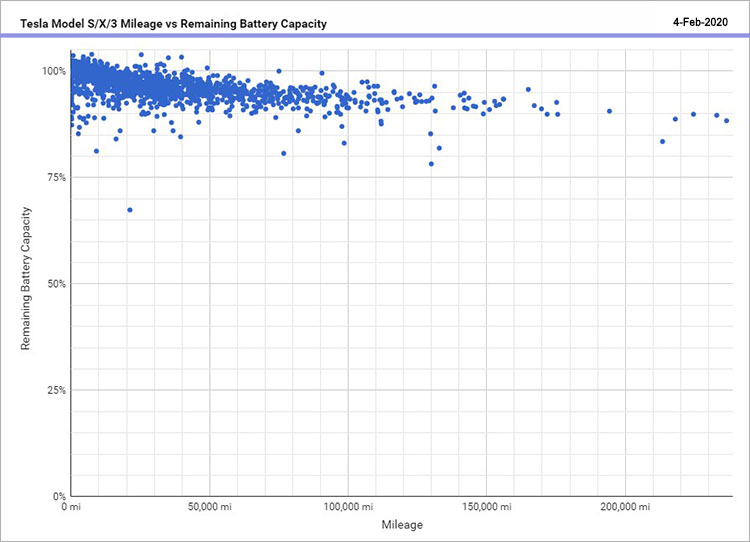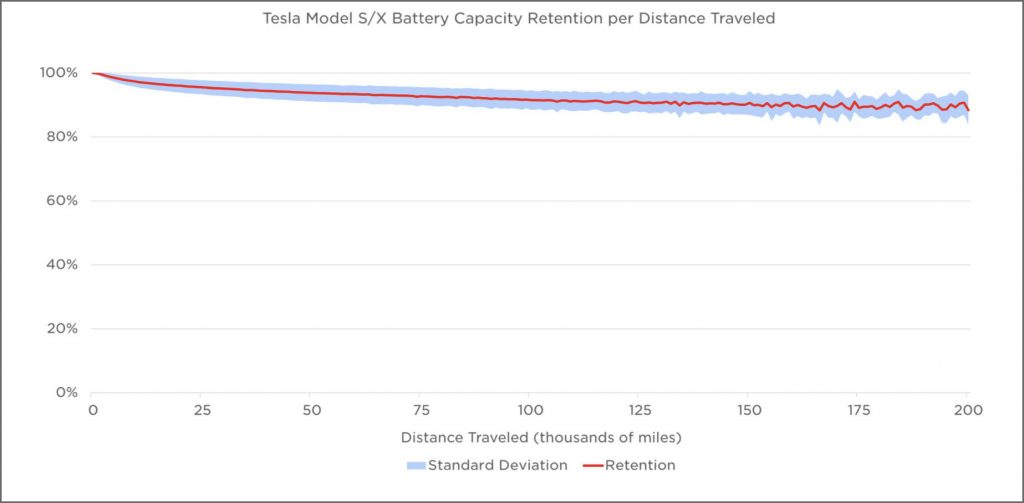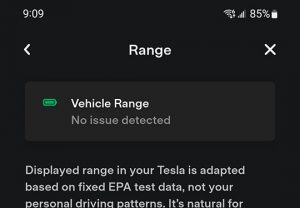
A lot of new owners are confused about the range and think there is something wrong with the battery or their car. We’ll help you understand what the indicated range means and why what you sometimes see as the range is more or less than the real range. (Jun-2025)
Inaccurate Range Displays
In an ICE car, the gas gauge is quite inaccurate and typically shows full, ½ full and empty, along with a low fuel light. As you go up or down long hills, the amount of gas shown by the indicator may change significantly. We doubt even 1% of ICE owners have a clue as to the range of their car at full and have only a vague idea of how far they can travel looking at a gas gauge. We’ve been trained to just fill up when it gets low – a very weak sense of what range the car has at any point. Some ICE cars do have a range display similar to Tesla. These displays have no knowledge of your future driving environment and need to key off of the low accuracy fuel gauge.


With EVs and Tesla, in particular, a range display shows the distance left available to travel. While this is far more precise than a gas gauge, it is not always accurate either.
State of Charge
A lithium-ion cell uses a chemical reaction for which you can’t measure the chemical state without disassembling the battery! You can measure the available voltage, but other than near the ends of the range, below 10% and above 90%, the voltage is constant.
The State of Charge (SOC) is needed to display the range. You can measure accurately the amount of energy added to the battery during charging and regeneration, and the energy removed to run the motor and accessories. Using this technique, the SOC is estimated. The longer the EV runs within the 10% to 90% band, there are small measurement errors that build up over time. Tesla ensures the indicated SOC goes slightly down over time – a safer choice than going up and fooling an owner that there is more range than the battery really has. Regardless of the SOC errors, the battery always has the same capacity and real range, just the indication shown is lower than reality. In a later section, we’ll show how to recalibrate for the small SOC errors that build up over months of use.

Converting the State of Charge to Distance
While this is a simple calculation, it is only accurate so long as you drive like the EPA combined mileage conditions. Tesla uses the EPA combined range as 100% SOC when the battery is new. At 0% SOC, you have zero range left. Time for an example!
Using a 2021 Model 3 LR AWD, it has an EPA range of 353 miles. So, at 100% SOC, you’ll have 353 miles of range. At 50% SOC it will show 353 * 0.50 = 176 miles. This means you have 176 miles left if you drive similarly to EPA conditions. That means 65 mph, on flat terrain, at 70°F, using low-rolling-resistance tires with rim inserts. Now if you drive at 85 mph, your range will be less, and if you drive at 35 mph your range will be extended. Your environmental conditions and driving style are not included in the range number.
When Real Range differs from Calculated Range
This table compares various conditions that will affect the EPA range in common ICE and EVs. A zero indicates the negligible effect on range, pluses add range, and minuses reduce range. Range effects are true for most ICE vehicles, but there are some exceptions. For example, some ICE cars have a stop engine feature when stopped, or may come with low-rolling-resistance tires.
| Item | ICE | EV |
|---|---|---|
| Added passengers and cargo | - - | - - |
| Cabin Cooling | - - | - - |
| Cabin Heating | 0 | - - - |
| Heated seats and steering wheel | - | - |
| High altitude | - - | + |
| Lights – Headlights, Fog, etc. | - | - |
| Low rolling resistance tires* | + | 0 |
| Low-profile sport tires or winter tires* | - | - |
| Moderate slowing | 0 | +++ |
| Navigation and maps | 0 | 0 |
| Playing the radio or streaming | 0 | 0 |
| Stop/Idle | - - | 0 |
| Strong Acceleration/Braking | - - | - - |
| Terrain - Going Downhill | ++ | +++ |
| Terrain - Going Uphill | - - - | - - - |
| Traveling at 45 mph | + | ++ |
| Traveling at 65 mph | 0 | 0 |
| Traveling at 85 mph | - - - | - - - |
| Wind - Headwinds | - - | - - |
| Wind - Tailwinds | ++ | ++ |
* Tires – For your Tesla, the standard OEM tires are used to meet the EPA range. For vehicles with rim inserts or rim covers, these are installed. If you select a performance tire option or use winter tires, your range will go down about 3-5%.
Different Display Modes
Tesla offers three ways to display how much battery power you have remaining. The battery icon always shows green as the battery SOC.
State of Charge
This shows the remaining battery power from 0 to 100%. These values do not consider any battery degradation, which means if after 10 years, your battery degrades by 7%, the SOC is 100% when fully charged. The milage range will show the 7% real battery degradation as fewer miles at 100% SOC.
Normal Distance
This is the most common and default mode when you buy the car new. It shows the distance remaining by using a combination of the SOC, the EPA combined rating, and includes battery degradation. As noted before, it tends to drift downward over time due to monitoring errors in the calculation.
Ideal Mode
This shows the distance you can travel to in optimum conditions. What those optimum conditions are is not totally clear. For example, driving long distances at a slower speed, such as 55 mph in 70°F clear weather, should give the range shown in Ideal mode.
Super Range
- 606 miles in a Model 3 LR (2018)
- 701 miles in a Model S100D (2018)
Low State of Charge Issues
As you get below 10% SOC or about 30 miles of range, other issues can come into play. Consider this range ONLY if you continue driving to your charge point. If you stop, and especially if you stop for more than a very short time, the range will quickly drop, perhaps even to zero!
The battery pack has a higher capacity when it is warm. Tesla even warms the battery in cold conditions to get more range. As you drive, draining the battery also warms the battery. When you stop, the battery immediately starts to cool. In very cold weather this can happen quite rapidly.
Let’s say you have 20 miles remaining and decide to stop for a quick bite before getting to the Supercharger 15 miles away. The battery cools, and when you get in, the battery has less capacity and may report zero miles left. The battery no longer has enough energy left to warm itself so it can get those last 20 miles! This is less of an issue in warm weather.
In an ICE car, you’re smart to avoid running the tank down to the last gallon, hoping you’ll find a gas station in time. Similarly, in your EV, it’s smart to keep more bottom end reserve so you’re sure to get to your next charging destination.
Range Calibration
While most long-timers have a good feel for the real range and don’t bother with range calibration, new owners may be worried something is wrong. You charge to 80% and interpolate up to 100% and have seemingly lost some range! What’s wrong?
You may need to recalibrate the range. You do this by driving the car down below 20% SOC, or better down to 10% SOC. You can do this over many days. Then charge up to 100%, preferably at home on an AC charger. Check the range within an hour or so of the car reaching 100%. This calibrates the range and provides a real 100% charge range value that includes battery degradation.
Some have stated you need to do this two or three times, but we don’t think that will make much if any difference. If you wait a number of hours after it reaches 100%, it is likely to drop 2-3 miles, and perhaps a lot more if you have certain features on like Sentry mode that consumes about 1 mile of range per hour.
When you charge to a specific level, the charger stops and will not turn back on until the battery drops by about 2-3% when not using schedule charging. With schedule charging, it will not start charging again until the next scheduled time.
Battery Degradation effects on Range
The battery pack slowly degrades depending on the amount it is used. For a typical 12,000 miles/year driving, you can expect 2-3% degradation in the first year, and around 1% per year thereafter. For a 2021 Model S LR, with 402 miles when new, in 5 years you can expect 6-7% degradation, or perhaps 373 miles at 100% SOC. Some owners have less degradation and some more.
Some small factors that can affect the degradation include
- Ambient temperatures throughout the year
- Your driving style
- The cell design, which has changed over the years
- How often you charge to 100% or go to < 10%
- How often you use DC Supercharging vs. AC home charging
We are not suggesting you change how you use your car, as these events have such a small effect on degradation, as compared with just driving. Enjoy driving and there really is no need to worry.
Here is a chart of self-reporting battery degradation with about 1500 data points. Thanks go to Matteo for the results collected from Tesla owners. The handful of data points below 85% are likely data entry errors or actual defective batteries, and not degradation.

Here’s a recent report from Tesla as of June-2020 that closely matches user data above:

Wrong Starting Range
Over the years, Tesla had made several advancements to increase range. In a few rare cases, they upped the range of an existing car. Be aware of what your original EPA range is, and you should assume that it hasn’t changed, ignoring degradation. Some owners with older cars pick up on the latest EPA numbers for brand new cars and think there is something wrong because the car doesn’t meet those new range numbers.
Is My Battery Pack Bad?
While exceptionally rare, the battery pack can fail. Here are the most common of those rare failures:
- A contactor shorts out – The contactor connects the battery pack to the rest of the car. There are two contactors, and if one shorts out, it can’t be fully disconnected. The car will provide a warning, but the car can be driven without issues. It should be repaired, but it is not urgent and should not strand you.
- A contactor sticks open – This high voltage switch must connect when needed. If it remains open the battery pack is disconnected and there is no motor power and the 12v battery can’t be recharged. The car must be towed to have it repaired.
- A module shorts out – This immediately drops about 4% range in the older S/X. While not urgent, the pack must be repaired or replaced. This is considered a failure rather than a degradation issue. For newer cars, there are no modules, but groups of cells. Should a single cell in a group short, the fuse for that cell blows, and the group and pack should continue to work fine with neglable degredation.
- The battery degrades below 70% capacity – We’re not aware of this ever happening yet.
You can now remotely test your own main battery. Open the Tesla app and select “Service”. Tap on “Battery”, select the “Range” option, then type in “loss of range” when it asks for a description and tap Next. The app will communicate with the car and run a self-diagnostic on the main battery. In under 10 seconds or so, it should return the status of the test. A successful test should return No issue detected.
Tesla can also remotely diagnose the battery if you still have a concern. Battery pack repairs must be done at a Service center. The 1000+ pound packs need special equipment beyond what Mobile service can handle.
Starting for the 2020 S/X and later cars and all Model 3/Y cars, Tesla offers a degradation warranty. If the pack delivers less than 70% from when it was new, within 8 years, Tesla will replace it. The packs that exist with over 250,000 miles seem to show about 15% degradation. Now there have been rare battery failures where either a module dies, or contactor fails. Both conditions are covered by the warranty. It should be noted that Tesla usually replaces a defective battery with a refurbished battery with similar degradation before the battery fails. So if you’re battery degraded by %7 after 5 years and failed, Tesla’s refurbished battery will have 7% or less degradation. It’s rare to get a brand-new battery unless the failure occurs when the car is very close to new
